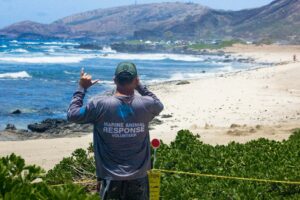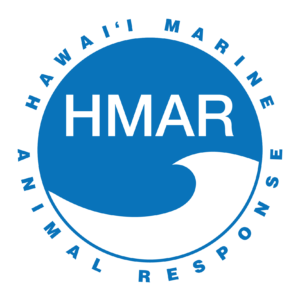MONTHLY HMAR UPDATE: October 2023
October was filled with partner cleanups, wedge-tailed shearwater colony surveys, and even more large marine debris retrievals! We’re so excited to tell you all about it! Click the link below to read all about it!
Number of contacts made to HMAR hotlines in October 2023 – 716 contacts
This is broken down as 531 contacts regarding Hawaiian monk seals, 120 contacts regarding sea turtles, and 20 contacts regarding seabirds. The remaining 45 contacts were not regarding marine animals of concern.
Number of field support actions conducted in October 2023 – 187 actions
This was broken down as 25 in the east section of Oʻahu, 88 in the lower west area, 2 in the upper west, 6 in the north area, and 66 in the southeast area of Oʻahu.
 October marked the commencement of our wedge-tailed shearwater colony surveys in Kahuku and Kailua. This year, with the invaluable assistance of our dedicated volunteers, the surveys went exceptionally smooth, and both colonies are holding up well! Notably, the Kailua colony boasted an impressive count of 26 chicks, more than doubling the figures from previous years. Meanwhile, the expansive Kahuku colony recorded 489 occupied burrows which was very close to last year’s results.
October marked the commencement of our wedge-tailed shearwater colony surveys in Kahuku and Kailua. This year, with the invaluable assistance of our dedicated volunteers, the surveys went exceptionally smooth, and both colonies are holding up well! Notably, the Kailua colony boasted an impressive count of 26 chicks, more than doubling the figures from previous years. Meanwhile, the expansive Kahuku colony recorded 489 occupied burrows which was very close to last year’s results.
In the upcoming weeks, these young shearwaters will prepare for their inaugural flights, signaling the onset of the “fall-out season.” These birds rely on the moon and stars for navigation, but artificial lights like street lamps and porch lights can lead them astray, causing confusion and mislandings. If you come across any seabirds in distress, please promptly report them to the statewide NOAA marine wildlife hotline at (888) 256-9840.
Mahalo!
Number of rescues, interventions, stranding responses, and escalated field actions in October 2023 – 29
This was broken down as 22 operations for sea turtles, 6 operations for seabirds, and 1 for Hawaiian monk seals. Of special note, we had one rescue operation for a rare hawksbill sea turtle hatchling and one large downed seabird.
At the beginning of the month, HMAR received a call about an entangled sea turtle on the sands of Mokuleia. Our responders sprang into action and swiftly made their way to the scene. Upon arrival and a thorough assessment, it was determined that the fishing line entanglement could be resolved on-site, allowing for the turtle’s safe release. Fortunately, the fishing line hadn’t constricted the turtle’s flippers tightly, and after our responder cut the line, the turtle eagerly returned to the ocean.
 This success story was followed by another entangled turtle incident at the end of the month. This report described a sea turtle entangled with fishing line around its front flipper, neck, and a hook in its mouth. After assessing the situation, our team decided that the turtle required transportation for further veterinarian assistance. Luckily there was a NOAA veterinarian nearby so rather than transporting the animal for care, by working together our team successfully removed the hook, disentangled the turtle, and released it right on the spot.
This success story was followed by another entangled turtle incident at the end of the month. This report described a sea turtle entangled with fishing line around its front flipper, neck, and a hook in its mouth. After assessing the situation, our team decided that the turtle required transportation for further veterinarian assistance. Luckily there was a NOAA veterinarian nearby so rather than transporting the animal for care, by working together our team successfully removed the hook, disentangled the turtle, and released it right on the spot.
Both of these cases illustrate the effectiveness of the statewide hotline in taking prompt action to help and release the animals. It’s also a vital reminder never to attempt disentangling a turtle, cutting line, or trying to remove hooks without having a trained responder present. Organizations like HMAR follow strict protocols to assess the turtle’s condition and ensure their well-being before any field interventions. Actions taken by untrained people can often cause an animal of concern more harm so please call the statewide NOAA wildlife hotline at (888) 256-9840 and let trained responders take action.
The month ended with another sea turtle hatchling rescue, a baby green sea turtle was found among the nearshore rock formations at KoOlina. Since no known turtle nesting sites exist in the area, our dedicated responders swiftly answered the call for assistance. Upon arrival, the individual had placed the tiny turtle in a bucket. To ensure its comfort during transport, our responder prepared a moist sand bed for the hatchling. With the turtle safely secured, we transported it to the west side and released it that night. This incident serves as a poignant reminder of the numerous challenges our turtle hatchlings face during their first hours to days of life, from potential predators and exhaustion to dehydration and the disorientation caused by nearby shore lighting.
among the nearshore rock formations at KoOlina. Since no known turtle nesting sites exist in the area, our dedicated responders swiftly answered the call for assistance. Upon arrival, the individual had placed the tiny turtle in a bucket. To ensure its comfort during transport, our responder prepared a moist sand bed for the hatchling. With the turtle safely secured, we transported it to the west side and released it that night. This incident serves as a poignant reminder of the numerous challenges our turtle hatchlings face during their first hours to days of life, from potential predators and exhaustion to dehydration and the disorientation caused by nearby shore lighting.
Marine Debris – Large Debris Recovery!
 We conducted seven marine debris in-water dives last month collecting 3,817 feet of monofilament line and 784 animal hazards. On top of our dives, as the State of Hawaiʻi Department of Aquatic Resources Marine Debris Rapid Response contractor for Oʻahu, HMAR was called out to three separate large net masses on the East side of the island! The first call came in the morning, from regular beach walkers who noticed a group of people attempting to remove a massive tangle of rope from the water. Our team gathered to assess the situation and the extent of the debris. Upon arrival, we discovered an enormous knot of incredibly thick rope that had washed up on Kailua Beach. Our team promptly began cutting the rope into more manageable sections and diligently carried them away, piece by piece. The combined weight of this colossal rope tangle exceeded 1,500 pounds.
We conducted seven marine debris in-water dives last month collecting 3,817 feet of monofilament line and 784 animal hazards. On top of our dives, as the State of Hawaiʻi Department of Aquatic Resources Marine Debris Rapid Response contractor for Oʻahu, HMAR was called out to three separate large net masses on the East side of the island! The first call came in the morning, from regular beach walkers who noticed a group of people attempting to remove a massive tangle of rope from the water. Our team gathered to assess the situation and the extent of the debris. Upon arrival, we discovered an enormous knot of incredibly thick rope that had washed up on Kailua Beach. Our team promptly began cutting the rope into more manageable sections and diligently carried them away, piece by piece. The combined weight of this colossal rope tangle exceeded 1,500 pounds.
Just three days later, another debris response was initiated, featuring almost identical rope debris. This time, our team carried the rope from the beach, which weighed approximately 200 pounds. The final debris response of the month involved a long, rolled net discovered in Waimānalo, successfully collected by an HMAR responder. We extend our heartfelt gratitude to all who contributed to these efforts and to the vigilant individual who alerted us to this significant animal hazard. If you ever encounter derelict fishing gear or nets, whether in the water or on land, please do not hesitate to contact our Hawaiʻi DLNR Marine Debris Rapid Response hotline at 833-4-DA-NETS.
debris. This time, our team carried the rope from the beach, which weighed approximately 200 pounds. The final debris response of the month involved a long, rolled net discovered in Waimānalo, successfully collected by an HMAR responder. We extend our heartfelt gratitude to all who contributed to these efforts and to the vigilant individual who alerted us to this significant animal hazard. If you ever encounter derelict fishing gear or nets, whether in the water or on land, please do not hesitate to contact our Hawaiʻi DLNR Marine Debris Rapid Response hotline at 833-4-DA-NETS.
Number of people reached through face-to-face outreach and education in September 2023 – 1,598 people
Last month, members of our team involved in our Education & Engagement Program continued their outreach work at Waikīkī Aquarium on Mondays from 11am-2pm. HMAR also participated in the Halloween event hosted at Sea Life Park this year.
Additional news & updates
 Our next volunteer orientation is December 2nd but applications are open! If you’re interested in joining the HMAR team, please visit our website and click on “Get Involved” or follow this link HERE. We offer a variety of programs that are always in need of participants. You can apply to become one of our Field Support & Outreach (FSO) volunteers who work on the beaches with monk seals, or become a marine debris volunteer participating in snorkel cleanup dives every weekend, or as a hotline operator from the comfort of your home in our Operations Support Program (OSP). Learn more by going HERE.
Our next volunteer orientation is December 2nd but applications are open! If you’re interested in joining the HMAR team, please visit our website and click on “Get Involved” or follow this link HERE. We offer a variety of programs that are always in need of participants. You can apply to become one of our Field Support & Outreach (FSO) volunteers who work on the beaches with monk seals, or become a marine debris volunteer participating in snorkel cleanup dives every weekend, or as a hotline operator from the comfort of your home in our Operations Support Program (OSP). Learn more by going HERE.
Mahalo for your support!
______________________________________________________________________________
WHAT DO THESE NUMBERS MEAN?
Number of Calls – What does this mean? These are contacts that our hotline operators answer about any species in any situation. Whether it is a monk seal on the beach, a sea turtle of concern in the water, or a seabird that needs help. HMAR answers the calls that are made to the NOAA’s marine wildlife number for Oʻahu and Molokaʻi and we take calls from the public, from the police, fire department, Ocean Safety as well as State of Hawaiʻi agencies. Some calls result in a field response but many are valuable for animal sightings information or other data that can assist in research. Since our start in 2016, we’ve handled over 63,700 hotline contacts.
Number of Field Support Actions – What does this mean? This is when HMAR sends volunteer or staff resources into the field to perform a variety of actions in support of marine protected animals including Hawaiian monk seals, sea turtles, sea birds, dolphins, whales or marine debris. Since our start in 2016, we have had volunteers or staff in the field over 27,490 times.
Number of Rescues, Interventions, Stranding Responses and Escalated Field Actions – What does this mean? This number includes any field response that goes above and beyond a typical resting monk seal response. This includes responding to a seal of concern, an entangled, hooked, or injured sea turtle, a seabird in need of medical support, and other situations. Since 2016, we have performed nearly 2,330 of these operations.
Marine Debris Work – Each week our marine debris team removes underwater entanglement hazards (net, line, hooks) from high fishing pressure areas to reduce animal entanglements, hookings, injuries and death of protected marine animals. Since we started our underwater removal activities, our Marine Debris Program (MDP) and our BEAT DEBRIS citizen science project has removed about 10,300 animal hazards, cleaned over 203 acres of underwater habitat, and we have collected over 23 miles of monofilament fishing line. Taking all of this debris out of underwater habitat helps save Hawaiian monk seals, sea turtles, and seabirds.
Number of People Reached through Face to Face Outreach – What does this mean? HMAR’s different program activities put our volunteers and staff in direct contact with Hawai’iʻs residents and visitors. Educating people about Hawai’i’s marine protected species and our ocean ecosystem is one of our highest priorities and has an important impact on reducing threats. This number includes outreach done in the field as well as the work our Education and Engagement team accomplishes through community outreach events and other educational activity. Since our start we’ve reached 318,250 people.

